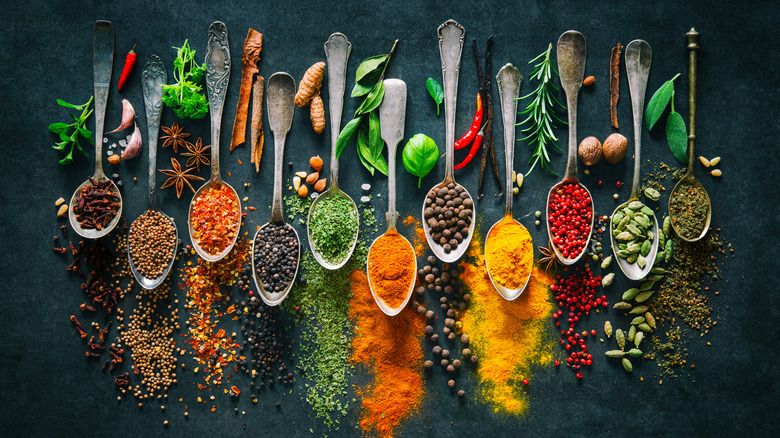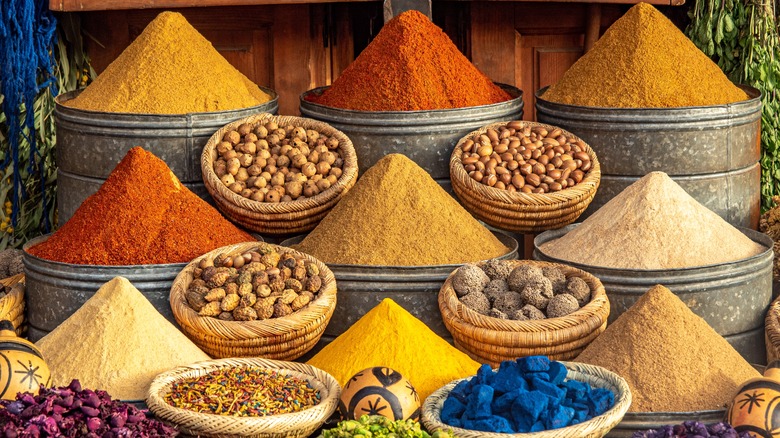Why You Should Think Twice Before Buying Spices At The Grocery Store
An integral part of the culinary world, spices have even spawned their own linguistic position as an everyday verb. We "spice up" our relationships or experiences by adding zest, relish, or interest, notes Merriam-Webster. It's a well-adapted use of language, considering how actual physical spices flavor our food in significant ways. They're simple to find in standard supermarkets — but is that the best way to source such an important recipe component?
Spices infuse complexity and panache into our favorite dishes, transforming them from ordinary to exceptional when used wisely. That's why a whole lot of people question things like sourcing, quality, storage, and pricing — all before those aromatic earth offerings even darken the doors of our homes. Where you purchase those spices can subtly affect what bubbles in your pot and graces your dinner plate. Here are a few things to consider and some sourcing options outside standard grocery store aisles.
Freshness, quality, and price
It stands to reason that supermarkets dealing in hundreds of long-term shelf-stable items may have products occupying space for months or even years, depending on expiration dates. Some ground and powdered spices technically last for up to three years and whole versions up to four years, depending on processing and storage, explains Healthline. But that doesn't mean they retain the same fresh taste, flavor, and strength, according to Spices Inc.
Specialty spice shops or high-end kitchen stores may offer a larger selection of fresh options, while also providing expert insights into spice variations, origins, and cooking applications. For example, Williams Sonoma shares knowledge about liquid spices such as vanilla, including characteristics, origins, and flavor profiles of vanilla beans from Madagascar, Tahiti, and Mexico.
Spice prices generally trend higher in traditional grocery stores. A Consumer Reports comparison study on the validity of high prices chose two spices, cinnamon, and oregano, and tested them at different price levels based on cost and brand names. The study involved three taste tests per spice in real-life food applications. Though the cinnamon prices ranged from $0.51 per ounce for the Walmart Great Value Leaves to $1.15 for McCormick and $4.14 for Spice Hunter Highland Harvested Saigon, the testers noticed no difference in taste when using the less expensive cinnamons in baked goods. However, the flavor was more intense in recipes in which cinnamon or oregano is the main ingredient, leading Consumer Reports to recommend paying higher prices in those circumstances.
Alternative buying options
Excellent alternatives exist for stocking your spice cabinet at more comfortable price points. Woman's Day gives a nod to ethnic stores where it's common to pick up spices and herbs at prices up to 90% lower than brand names in traditional grocery stores. An added advantage is discovering unique culinary cultures, interesting spices, and new recipes. Just invest in some high-quality glass bottles, since these spices typically sell in bags or bins.
Natural food stores are often derided for high costs, but frequently deliver on price when it comes to spices, according to Business Insider. That's because you can buy in bulk from bins, saving as much as 97% over brand-name spices. A stated example cites a grocery-store jar of bay leaves costing $3.52, while an equivalent amount at a natural foods store can set you back only 12 cents. An added bonus is increased confidence in the quality and sourcing, and you can buy only as much as you need at any given time. It's also an easy way to create your own seasoning mixes from affordable fresh spices.


